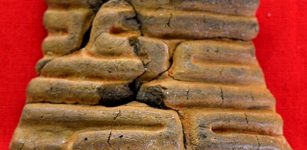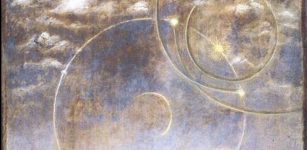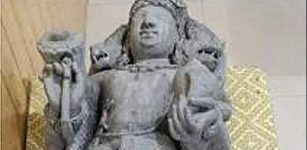Mysterious Etruscans: Skilled Sailors And Master Craftsmen
A. Sutherland - AncientPages.com - About 3000 years ago, a mysterious people called the Etruscans settled in a region of Central Italy known as Etruria. They were one of the most influential civilizations in ancient Italy before the rise of the Romans.
Although these ancient people were much closer to us in time, they were even more enigmatic and inaccessible than other ancient cultures such as Crete, Mesopotamia, or Mycenae, and we still have much to learn about them.
Researchers deciphered the language, but most Etruscan texts remain obscure because the language bears very little relation to other known languages. Scholars have recorded some thirteen thousand Etruscan inscriptions; the phonetic sounds of the Greek alphabet are known, so it also helps to reconstruct the Etruscan language's sound. At the same time, extensive texts left by this civilization are rare.
The origin of the Etruscans is lost in prehistory. According to Livy (Titus Livius, 59 BC-AD 17), the Etruscans had a rich literature, but almost all of it disappeared.
A few generations before Livy's time, young Romans studied the Etruscan literature as meticulously as they later did the Greek, but except for brief inscriptions on tombs, mirrors, or pottery, none of this work has survived. So, all we know about the Etruscans comes mainly from Greek and Roman sources. The Greeks called their land "Hesperia," and the Etruscans were called "Tyrrhenians," probably after Tyrrhenus, fifth in descent from the god Zeus and one of the founders of the Etruscan Federation of twelve cities.
Extent of Etruscan civilisation and the twelve Etruscan League cities. Image credit: Norman Einstein (Based on a map from The National Geographic Magazine Vol.173 No.6 June 1988). CC BY-SA 3.0
Ancient Etruria was situated on the western side of Italy, between the Apennines and the Tyrrhenian Sea. It extended from the land about the Arno River in the north to the Tiber River in the south and included modern Tuscany, which takes its name from the Etruscans. At one period, the Etruscans controlled Campania and the basin of the Po River and reached the northern Adriatic. Speculations regarding their origin have never ceased. Some scholars speculated they came from the Danube, while others proposed the North of the Alps region.
Herodotus claimed their arrival from Lydia, modern Anatolia in Asia Minor, but the Etruscans did not speak Lydian, worship Lydian gods or follow Lydian laws.
Many of the most famous cities in Italy were originally Etruscan. Among them are Pisa, Arezzo, Cortona, Siena, Volterra, Orvieto, Perugia, Assisi, and others also worth mentioning. Rome was once an Etruscan center, and the islands of Elba and Corsica were also Etruscan.
Left: Ear-stud decorated with a rosette surrounded by concentric bands. Gold with vitreous glass paste insets, 530–480 BC; source; Right: The Ancient Thracian Golden Orphism book, discovered in 1955, in the Struma River valley, in Bulgaria. It is exposed in the National History Museum in Sofia. Image credit: Ivorrusev - CC BY-SA 4.0
But there were other towns, either deserted or forgotten in the decline of Etruscan cultures, such as Veii, Tarquinia, Cerveteri, and Chiusi, where archeologists have found rich remains.
As scientists have not been able to study their language, they have always had to rely on the archeological excavations of their cities and numerous cemeteries. These sites, unfortunately, suffered more than two hundred-year-long plunderings before professional archaeologists could finally enter the ancient sites and begin their work in the field.
Scholars have long analyzed ancient records and tried to decipher the Etruscan inscriptions. Especially by the end of the century, many Etruscan remains were unearthed, painted, and figured pottery, gold vessels with a variety of domestic equipment in the form of candelabra, lamps, beautifully engraved mirrors, terracotta, and bronze objects.
Other priceless items found by diggings, of which many showed Greek and Roman influence - included bracelets, pendants, fibulae, rings, and other jewelry. Others, on the other hand, were not of Roman or Greek origin. They had once belonged to the enigmatic and relatively unknown civilization of people known as the Etruscans.
Discovered tomb paintings shed light on the life of the Etruscans, showing, for example, that women were given an honored place in society.
Urn in the shape of a hut, which represents the typical Etruscan house of the Villanovan phase, 8th century BC, from Vulci, Musée d'art et d'histoire de Genève. Image credit: Dom8Mi - CC BY-SA 3.0
They are depicted as banqueting with male guests and being embraced by their husbands. Also, funerary inscriptions have revealed many names of the deceased's female and male ancestors.
Etruria was rich, and the primary source of this wealth were valuable minerals concentrated in the vicinity of the Metalliferous Hills ('Colline Metallifere') with plenty of copper, iron, zinc, and tin. In exchange for these crucial minerals, the Etruscans could import ivory, silver, and gold, which they appreciated so much.
The mysterious, seafaring Etruscan civilization flourished until the end of the second century B.C. when they were finally included in Roman culture. There is still much to learn about these people, and a fascinating debate regarding the Etruscans continues.
Some scholars believe that the Etruscans were the descendants of an oriental group that settled in western Italy after 1000 BC. Meanwhile, others suggest that the Etruscans were instead an indigenous race with culture and traditions developed in Italy from the beginning. With time, their culture was only subjected to influences from the east.
However, when and where the Etruscans came to Italy is still unclear. Their roots are traced to Turkey rather than Italy.
Written by – A. Sutherland AncientPages.com Staff Writer
Updated on November 8, 2022
Copyright © AncientPages.com All rights reserved. This material may not be published, broadcast, rewritten or redistributed in whole or part without the express written permission of AncientPages.com
Expand for referencesMore From Ancient Pages
-
 Iron Age Site Tell Deir ‘Alla (“Mound Of The High Monastery”) Flourished 400 Years In Central Jordan Valley
Archaeology | Jul 25, 2022
Iron Age Site Tell Deir ‘Alla (“Mound Of The High Monastery”) Flourished 400 Years In Central Jordan Valley
Archaeology | Jul 25, 2022 -
 Well-Preserved 7,300-Year-Old Wooden Cabins Discovered In La Draga
Archaeology | Oct 23, 2023
Well-Preserved 7,300-Year-Old Wooden Cabins Discovered In La Draga
Archaeology | Oct 23, 2023 -
 10 Great Viking Misconceptions Still Being Perpetuated
Featured Stories | Jan 11, 2019
10 Great Viking Misconceptions Still Being Perpetuated
Featured Stories | Jan 11, 2019 -
 A 1,600-Year-Old Mosaic Accidentally Unearthed In Ancient City Of Yavne, Israel
Archaeology | Apr 26, 2021
A 1,600-Year-Old Mosaic Accidentally Unearthed In Ancient City Of Yavne, Israel
Archaeology | Apr 26, 2021 -
 3,000-Year-Old Piece Of Pottery Unearthed On Okinawa Island, Japan
Archaeology | Feb 21, 2017
3,000-Year-Old Piece Of Pottery Unearthed On Okinawa Island, Japan
Archaeology | Feb 21, 2017 -
 Should Scientists Open An 830-Million-Year-Old Rock Salt Crystal With Ancient Microorganisms That May Still Be Alive?
Archaeology | May 27, 2022
Should Scientists Open An 830-Million-Year-Old Rock Salt Crystal With Ancient Microorganisms That May Still Be Alive?
Archaeology | May 27, 2022 -
 Rich 2,000-Year-Old Chinese Tomb May Reveal Secret Identity Of Its Owner
Archaeology | Dec 18, 2015
Rich 2,000-Year-Old Chinese Tomb May Reveal Secret Identity Of Its Owner
Archaeology | Dec 18, 2015 -
 ‘Umeda Graves’ Dated To Edo Period Discovered At Osaka, Japan
Archaeology | Aug 21, 2020
‘Umeda Graves’ Dated To Edo Period Discovered At Osaka, Japan
Archaeology | Aug 21, 2020 -
 On This Day In History: Vädersol Painting Depicting ‘Sun Dog’ Phenomenon Observed Over Stockholm – On Apr 20, 1535
News | Apr 20, 2016
On This Day In History: Vädersol Painting Depicting ‘Sun Dog’ Phenomenon Observed Over Stockholm – On Apr 20, 1535
News | Apr 20, 2016 -
 Indus Civilization And Complex Patterns Of Urbanity – New Study
Archaeology | Feb 21, 2022
Indus Civilization And Complex Patterns Of Urbanity – New Study
Archaeology | Feb 21, 2022 -
 Unusual Rock With Ancient Paintings Discovered By Hiker In Norway
Archaeology | Jun 23, 2023
Unusual Rock With Ancient Paintings Discovered By Hiker In Norway
Archaeology | Jun 23, 2023 -
 Brokkr And Eitri – Norse Dwarves Who Fashioned Magical Artifacts For The Gods
Featured Stories | Aug 19, 2019
Brokkr And Eitri – Norse Dwarves Who Fashioned Magical Artifacts For The Gods
Featured Stories | Aug 19, 2019 -
 Abu Simbel – Spectacular Ancient Egyptian Temples Unique In Design And Size
Featured Stories | Jun 12, 2021
Abu Simbel – Spectacular Ancient Egyptian Temples Unique In Design And Size
Featured Stories | Jun 12, 2021 -
 Untold Story Of Mexico’s Ancient Giant Indians – Secret Knowledge Of The Aztecs Revealed – Part 1
Featured Stories | Sep 21, 2019
Untold Story Of Mexico’s Ancient Giant Indians – Secret Knowledge Of The Aztecs Revealed – Part 1
Featured Stories | Sep 21, 2019 -
 Unique Female Viking Grave In Swedish Mountains Reveals Its Secrets
Archaeology | Jul 14, 2023
Unique Female Viking Grave In Swedish Mountains Reveals Its Secrets
Archaeology | Jul 14, 2023 -
 Sculpture Of Lord Vishnu Dated To The Early 9th Century Found In Kashmir
Archaeology | Aug 4, 2022
Sculpture Of Lord Vishnu Dated To The Early 9th Century Found In Kashmir
Archaeology | Aug 4, 2022 -
 Spectacular 2,500 Years Old Shwedagon Pagoda In Myanmar – World’s Oldest Pagoda
Featured Stories | Oct 18, 2018
Spectacular 2,500 Years Old Shwedagon Pagoda In Myanmar – World’s Oldest Pagoda
Featured Stories | Oct 18, 2018 -
 Mama Pacha: Respected And Feared Supreme Goddess Of The Andean People
Featured Stories | Jul 23, 2020
Mama Pacha: Respected And Feared Supreme Goddess Of The Andean People
Featured Stories | Jul 23, 2020 -
 Where Is One Of Colorado’s Most Mysterious Long-Lost Artifacts? Have New Clues Emerged?
Featured Stories | Aug 20, 2024
Where Is One Of Colorado’s Most Mysterious Long-Lost Artifacts? Have New Clues Emerged?
Featured Stories | Aug 20, 2024 -
 Unexplained Mysteries Of The Superstition Mountains – A Gateway To Other Worlds?
Featured Stories | Dec 15, 2020
Unexplained Mysteries Of The Superstition Mountains – A Gateway To Other Worlds?
Featured Stories | Dec 15, 2020




